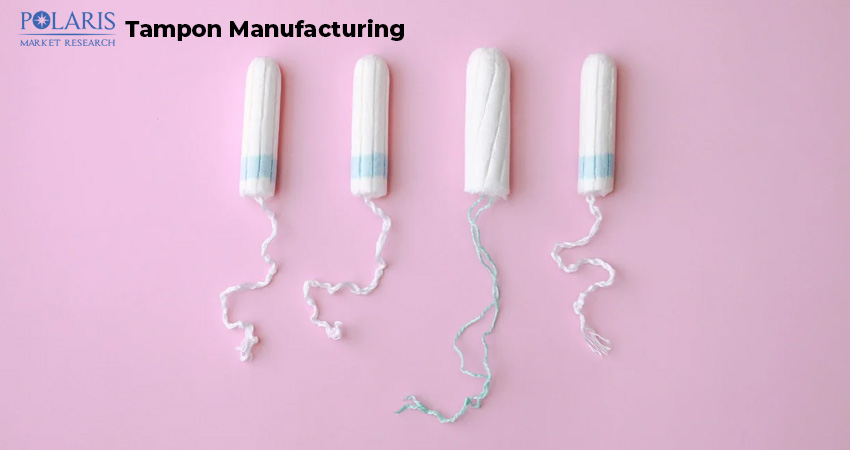Top 5 Companies Driving Change in Tampon Manufacturing

In today’s ever-changing world, innovations in materials, eco-friendly options, and inclusivity are redefining how we perceive menstrual care. The tampon industry is a significant segment of the broader feminine sanitary ware products, which encompasses a variety of products designed to provide comfort and convenience during menstruation, including pads, pads, and tampons.
From its humble beginnings to the latest adaptations it is accepting, join us on the journey of exploring this sector. In this blog, we will delve into the key players in the tampon industry, the trends shaping its future, and the challenges it faces.
Understanding Tampons
To absorb menstrual fluid, a tiny, cylindrical device called a tampon is placed inside the vagina. A form of internal period protection, tampons are composed of soft, absorbent materials such as rayon or cotton. They are part of a variety of famine sanitary wear products alongside pads and menstrual cups. Designed for single use, they are available in various sizes and absorbencies. Tampons are a widely used menstrual product, valued for their convenience and distinct design. Over the years, it has grown beyond just offering products to advocating for menstrual health awareness and breaking social stigmas.
Why do Tampons Matter?
Tampons have significantly impacted menstrual health by:
- Providing Mobility: Their distinctive and compact nature allows individuals to participate in sports and other activities without interruption.
- Encouraging Hygiene: With proper usage, tampons are a safe and effective way to manage menstrual flow.
- Driving Inclusivity: Modern tampon brands are catering to diverse needs, including hypoallergenic options and products for varying flow levels.
What’s Fueling Tampons Demand?
- Organic and Eco-Friendly Products: Tampons made of organic cotton, without dangerous chemicals, and biodegradable packaging are becoming more popular as consumers grow more environmentally conscious and health conscious. Manufacturers are being prompted to innovate and provide products that meet the changing expectations of consumers as a result of this trend, which is in line with larger movements towards the use of sustainability and personal health.
- Government Initiatives: Government campaigns to raise awareness of menstrual hygiene help fuel the expansion of the tampon market. Promoting access to sanitary ware products and educating women about menstrual health is crucial for raising tampon usage rates. By normalizing conversations about menstruation, these programs encourage women to choose tampons as a dependable method of managing their periods.
- Rapid Urbanization: Modern hygiene products are becoming more and more popular as urban populations increase and lifestyles change. Tampons are now more widely available to consumers thanks to their availability in pharmacies, supermarkets, and online marketplaces, which has increased adoption rates.
- Development of Inclusive Products: In order to meet the unique needs of various consumer groups, such as those with disabilities, allergies, or sensitivities, brands are increasingly creating inclusive tampon products. The demand for specialized tampon options is increased by inclusive product development, which guarantees that everyone has access to comfortable and safe menstrual hygiene solutions.
- Increasing Demands for Tampons Made of Blended Materials: Blended tampons are non-allergic, long-lasting, safe, and comfortable. To make their tampons, a number of manufacturers combine cotton and rayon fibers. Additionally, blended-material tampons are less costly than those made of other materials that are sold in stores. Ultimately, there is a growing global need for blended tampons that are both inexpensive and absorbent.
Leading Market Participants
- Procter & Gamble (Tampax): Tampax, a flagship brand of Procter & Gamble, is one of the most recognized names in the tampon market. It has its headquarters in Cincinnati, Ohio, USA. Known for its wide range of products, Tampax continues to innovate with organic lines and applicator-free options to cater to eco-conscious consumers.
- Kimberly-Clark (U by Kotex): Headquartered in Irving, Texas, USA, Kimberly-Clark was established in Neenah, Wisconsin, in 1872. In 1920, the company introduced the Kotex brand, which is currently a part of the U by Kotex range of feminine care products. Kimberly-Clark’s U by Kotex brand focuses on empowering menstruators with stylish, functional, and sustainable tampons.
- The Honest Company: In 2011, Jessica Alba, Christopher Gavigan, and Brian Lee founded the well-known The Honest Company with the simplified goal of making safe and efficient products for families. Its headquarters is in Los Angeles, California. The Honest Company offers organic cotton tampons designed for comfort and safety.
- Natracare: Founded in 1989 by Susie Hewson, the British feminine hygiene company Natracare manufactures tampons, sanitary pads, and panty liners, among other organic and plastic-free menstrual products. It has its headquarters in Bristol, England, UK. It is a pioneer in natural menstrual products, offering 100% organic cotton tampons. Their commitment to environmental sustainability and ethical practices has earned them a loyal following.
- Seventh Generation, Inc.: US-based Seventh Generation, Inc. sells environmentally friendly paper, cleaning, and personal care products. It was founded in 1988 and has headquarters in Burlington, Vermont, USA. It's well-known for its eco-friendly household products, including organic tampons. Their biodegradable applicators and plastic-free packaging appeal to sustainability-focused consumers.
Challenges for Tampon Market
While the tampon market is flourishing, it faces several challenges, which are:
- Environmental Concerns: Traditional tampons contribute to plastic waste, prompting demand for greener alternatives.
- Health Misconceptions: Myths about tampon safety, such as fears of toxic shock syndrome, persist despite efforts to educate consumers.
- Cultural Stigmas: In many regions, societal taboos around menstruation hinder market growth.
- Affordability and Accessibility: High costs and limited availability remain barriers for many menstruators, especially in developing countries.
Future Outlook
The tampon market is about to experience a major change. It is not just about products but also about empowering individuals, fostering sustainability, and breaking down barriers. As we move forward, companies and consumers alike will play a pivotal role in shaping a future where menstruation is met with dignity and care. So, what’s next for tampons? The answer lies in the hands of a conscious and innovative world!

